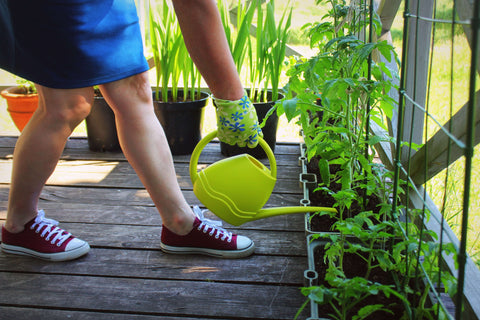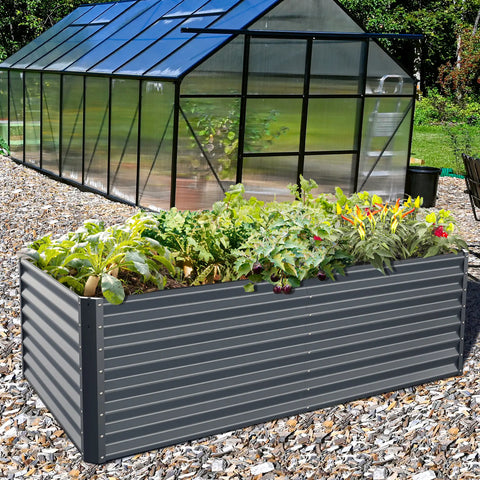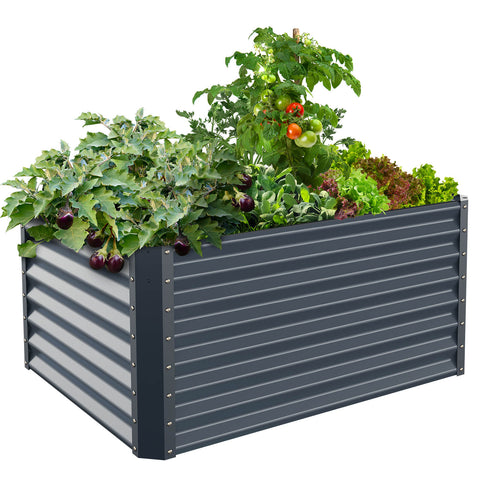If you want to grow the most vegetables in your garden, then high-yielding vegetables are the way to go. Whether you're an experienced gardener or just starting out, growing high-yielding vegetables in an elevated garden bed is a great way to increase your harvest and get the most out of your gardening efforts.
Read on to learn more about high-yielding vegetables, the benefits of growing them, and how to choose the best vegetables for your garden bed.

What are high-yielding vegetables?
High-yielding vegetables produce a lot of produce per plant, making them an excellent choice for gardeners looking to grow crops without taking up too much growing space. These vegetables are easy to grow and are a great option for those who are new to gardening or have limited space.
One of the main benefits of growing high-yielding vegetables is the amount of produce they provide. These vegetables usually produce more crops per plant than other varieties, which means you'll have more fresh vegetables to enjoy.
Another benefit of growing high-yielding vegetables is that they are a great option for those with limited garden space. Because they yield more per plant, you don't need to grow as many, which means you can grow a lot of vegetables in a small space.
How to choose the best high-yielding vegetables for your garden?
When choosing high-yielding vegetables for your garden, it's important to consider the size of your available space, as well as the amount of sunlight your garden receives. Some high-yielding vegetables, such as squash and zucchini, require a lot of space to grow, while others, such as leafy greens, can be grown on a smaller area.

It's also important to choose vegetables that are appropriate for the growing season and climate. Some vegetables grow best in cool weather, while others thrive in warm weather. Therefore, choosing the right time of year to plant vegetables is crucial.
Common high-yield vegetable
If you're looking for high-yielding vegetables, you can't go wrong with cucumbers, lentils, radishes, squash, zucchini, peas, and tomatoes. These vegetables are easy to grow, and each plant produces a large amount of produce, providing you with a harvest that lasts for weeks.
Cucumbers, for example, are perfect for picking and eating as is, while tomatoes are an excellent ingredient in salads, sandwiches and sauces. On the other hand, growing potatoes on raised beds is also a great option to provide delicious ingredients for your home.
If you have the space, grow larger vegetables, such as pumpkins, watermelons and peppers, for a higher yield. Not only will these vegetables give you a good harvest, but they're also fun to grow and watch as they ripen.
So if you're interested in maximizing the yield per plant in your garden, consider growing some of these vegetables and enjoying the benefits of gardening.

Why grow vegetables on raised garden beds?
Raised garden beds are a popular choice for gardeners for many reasons. They have several advantages over traditional garden beds, including improved soil quality, better drainage, and easier weeding and harvesting.
Specific options such as a 3 storey raised garden bed or specific models such as Lazy Curve 4' x 12' raised garden bed are very good for maximising your harvesting potential. Because of their vertical design and larger soil capacity, these beds can grow more plants in the same space than traditional flat beds, which means more vegetables can be grown per square foot of land.
Raised garden beds are also a great option for gardeners with limited space, as they allow you to make the most of your garden space. They can be built in any size or shape, and can even be built to fit small or difficult-to-use areas such as balconies or roofs.
How to build elevated garden beds for high-yielding vegetables?
Building a raised garden bed for high-yielding vegetables is relatively easy and can be done in just a few hours. Choose a sunny, well-drained area first, then the size and shape of the bed. Build the bed out of a high-quality material such as cedar or redwood, then fill it with a rich compost and soil mixture.
Beyond that, keep in mind that raised garden beds require some maintenance to ensure they remain productive. Ensure regular fertilization and crop rotation to prevent pests and diseases from destroying vegetables. Finally, make sure you water regularly so that your plants stay healthy and consistently produce high yields of vegetables.
Best soil and compost high-yielding vegetables in a raised bed
When it comes to choosing soil and compost for your garden bed, it's important to choose high-quality materials that will provide your plants with the nutrients they need to grow and produce. Look for a nutrient-rich soil mix that contains lots of compost, organic matter, and other essential nutrients.
For example, you can use a combination of compost, topsoil, and organic material to create the perfect combination for growing vegetables. You may also want to add some worm droppings or other natural fertilizers to give your plants an extra boost.
Finally, make sure you cover your seedbed with straw, grass clippings or tree bark shavings to help keep the soil moist and retain nutrients. This will help ensure that your vegetables get the right amount of water and nutrients they need to thrive.

What are the best high-yielding vegetables to grow in a small garden?
If you want to maximize your harvest in a small garden, there are several high-yielding vegetables that are perfect for you. These vegetables are perfect for smaller garden Spaces and can produce many products per plant.
Leafy green vegetables such as lettuce and kale
Leafy greens like lettuce and kale are ideal for small gardens because they can be grown in close rows, allowing you to maximize the use of garden space. They grow quickly and can be harvested throughout the growing season, providing you with a steady supply of fresh produce.
Vines like cucumbers and beans
Another good option for a small garden is to grow plants such as cucumbers and beans. These plants can be grown on trellises or other vertical supports, allowing you to maximize the use of garden space and increase the amount of planted area per square foot.
Pumpkins and zucchini promise a good harvest
Pumpkins and zucchini are also good choices for small gardens, as they produce plenty of fruit per plant. These vegetables require a lot of space to grow, but you can maximize your harvest by planting a few plants and harvesting them regularly throughout the growing season.
How to maximize the productivity of garden beds?
If you want to maximize your garden's harvest, there are several things you can do to increase production and make the most of your garden space.
High yield complementary planting
Planting in groups is a great way to increase the yield of your garden. By growing certain vegetables together, you can create a more productive garden environment that produces more yield per square foot of planted area.
Trellises and vertical gardening save space and increase production
Trellises and vertical gardening are other good options for maximising productivity in a garden bed. By training your plants to grow vertically, you can save space and produce more per square foot planted. If your plants need extra support, you can use our vegetable wall.
Continuous planting, continuous harvest
Continuous planting is another great way to increase productivity in garden beds. By planting a new crop immediately after harvesting your existing crop, you can ensure a continuous supply of fresh produce throughout the growing season.
conclusion
Growing high-yielding vegetables on a raised bed is a great way to produce lots of fresh produce in a small space. Whether you're an experienced gardener or just starting out, there are plenty of high-yielding vegetables to choose from that are easy to grow and each plant produces a lot of produce. By choosing the right vegetables for your garden, building a garden bed with high-quality soil and compost, and utilizing companion planting, trellises and continuous growing techniques, you can maximize your harvest and enjoy an abundant supply of fresh produce throughout the season.
Q&A
What high-yielding vegetables can be grown on raised garden beds?
Some high-yielding vegetables grown in a raised bed garden include peas, cucumbers, lentils, zucchini, squash, leaf lettuce and radishes.
How can I ensure a bountiful harvest from my garden?
Continuous planting and vertical planting are two techniques that can help increase yields. It also helps to grow vegetables that are known to produce bumper crops.
Can I grow vegetables in a garden bed all year round?
Depending on your climate and the type of vegetables you want to grow, you can use your elevated garden bed for year-round gardening.
What kind of soil should I use in my planted garden?
It is recommended to use well-drained soil for garden beds. In addition, adding organic matter to soil helps improve soil quality.
Can I grow tomatoes in my garden bed?
Yes, tomatoes can be grown on raised garden beds. However, they need a lot of space and full sunlight to thrive.
Can I grow vegetables indoors?
While raised garden beds are usually used for outdoor gardening, they can also be used indoors if you have the space and plenty of lighting.
What are some tips for planning a garden layout on a raised garden bed?
When planning your garden layout, consider the kinds of vegetables you want to grow, their spacing needs, and how they will be arranged vertically if needed.
What kinds of vegetables are best for growing in cultivated garden beds?
The best vegetables are the ones that provide the best flavor and make you money. Some good choices include bush beans, leaf lettuce, cucumbers and squash in a variety of colors.









